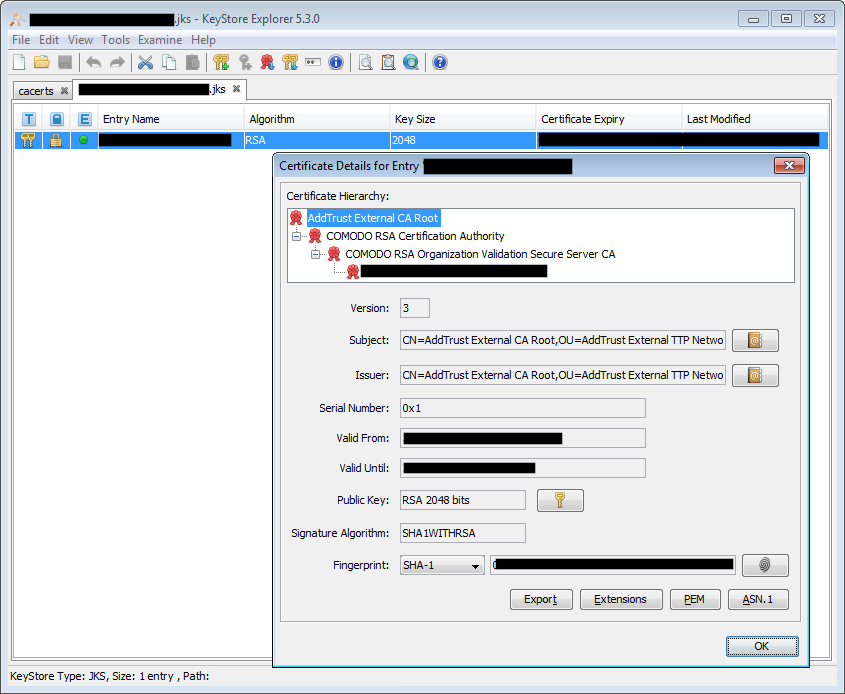
- KEYSTORE EXPLORER SHOWING NULL CERTIFICATE CHAIN SERIAL NUMBER
- KEYSTORE EXPLORER SHOWING NULL CERTIFICATE CHAIN PASSWORD
Use this method if you want to generate an CSR that you can send to a CA to request the issuance of a CA-signed SSL certificate.
KEYSTORE EXPLORER SHOWING NULL CERTIFICATE CHAIN PASSWORD
This will prompt for the keystore password (new or existing), followed by a Distinguished Name prompt (for the private key), then the desired private key password. If the specified keystore does not already exist, it will be created after the requested information is supplied. This command generates a 2048-bit RSA key pair, under the specified alias ( domain), in the specified keystore file ( keystore.jks): keytool -genkeypair \ This will create a new key pair in a new or existing Java Keystore, which can be used to create a CSR, and obtain an SSL certificate from a Certificate Authority. Use this method if you want to use HTTP (HTTP over TLS) to secure your Java application. This section covers Java Keytool commands that are related to generating key pairs and certificates, and importing certificates. Most of the commands are one-liners that have been expanded to multiple lines (using the \ symbol) for clarity.Jump to any section that is relevant to the task you are trying to complete (Hint: use the Contents menu on the bottom-left or your browser’s Find function).This guide is in a simple, cheat sheet format–self-contained command line snippets.If you are not familiar with certificate signing requests (CSRs), read the CSR section of our OpenSSL cheat sheet.This includes creating and modifying Java Keystores so they can be used with your Java applications. This cheat sheet-style guide provides a quick reference to keytool commands that are commonly useful when working with Java Keystores. A keystore entry is identified by an alias, and it consists of keys and certificates that form a trust chain. Its entries are protected by a keystore password. A Java Keystore is a container for authorization certificates or public key certificates, and is often used by Java-based applications for encryption, authentication, and serving over HTTPS. Java Keytool is a key and certificate management tool that is used to manipulate Java Keystores, and is included with Java. ExamineClipboard works now also with URLs if they end with one of the following extensions.Improved usage of JavaFX file chooser in various ways (contributed by Colbix).This is definitely a feature for advanced users who know what they are doing, Only a matter of encoding the value correctly. More complex extensions are of course also possible, it is

Of the DER-encoded ASN.1 value for type "Object Signing":īIT STRING (tag "03") with length "02" bytes, 4 unused bits Netscape-cert-type and 03020410 is the hexadecimal encoding KSE 5.5.0 but you can still add them as a custom extension. The old and obsolete Netscape extensions were removed in Just leave the input field for the extension empty X.509 extensions because it has ASN.1 "NULL" as its The "OCSP No Check" extension is one of the most simple The value has to be entered as the hexadecimal encoding of theĭER-encoded ASN.1 value of the extension without the encapsulating The extension and the value as a hex encoded string. With this new feature any extension canīe added to a new certificate by entering the object ID (OID) of There are however someĮxotic or non-public extensions that are completely out of Used certificate extensions can be added. When generating a certificate with KSE, a wide range of commonly This feature was contributed by Jairo Graterón.

This makes creating subsequent CRLs much easier.
KEYSTORE EXPLORER SHOWING NULL CERTIFICATE CHAIN SERIAL NUMBER
The feature uses an automatically created file with the issuer serial number as its name and ".db"Īs its extension to save meta data like CRL serial number, the revoked certificates and the validity The generated CRL can then be saved to the file system in PEM or DER format.

Previous versions of KSE had some basic CA features like signing X.509Ĭertificates, key creation, PKCS#10 requests, support for many


 0 kommentar(er)
0 kommentar(er)
